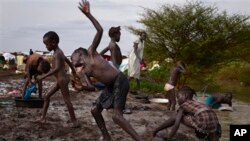The U.N. Food and Agriculture Organization says it has less than half the funding it needs to help ensure food security in parts of South Sudan. The agency wants to send emergency livelihood kits to farmers, fishers and pastoralists as the risk of famine grows.
The FAO has appealed for $108-million for its revised Crisis Response Plan. But so far it’s received just $42-million.
Jeff Tschirley, who’s in charge of the agency’s Emergency and Rehabilitation Division, said conflict is complicating the humanitarian crisis.
“The situation started off badly in December when the violence started. But in the last six weeks we’ve seen a very sharp deterioration in the food security situation. More than a third of the population is at level four or level five in the index that we use to measure food security. And there’s a significant risk of an impending food crisis.”
The conflict has taken a severe toll on South Sudan.
”Reserves are exhausted. Infrastructure’s been damaged. Assets have been abandoned. Agricultural cycles and such [have] been disrupted. And there’s a major problem with access due to the security situation,” he said.
The areas hardest hit by fighting between government forces and rebels are Jonglei, Upper Nile and Unity States. There are many displaced people there.
Tschirley said, “[You’ve] got camps set up nearly spontaneously by people where they think they might be able to find some security. But it still involves women going out into the countryside to fetch firewood, or for other things, that really exposes them to significant risk. The other states – the ones that are more calm – those are less impacted. In those cases we are actually focusing on boosting food production by providing quality seed and planting materials, veterinary services and things like this.”
The FAO’s emergency livelihood kits contain seeds, fishing hooks and—what it calls – fundamental survival tools.
Tschirley said the FAO would be able to help many more people if it receives the full $108 milliion requested.
“If we are able to get the additional resources to come up to 108 million, we’ll be able to support another two-million people with these livelihood kits. So far, we’re supporting a little over 200,000 vulnerable households. That’s about [1.2 million] people. In this case we’ve targeted the riverine areas. These areas also are in their rainy period. And access becomes more problematic the longer we go into the period,” he said.
The FAO says time is of the essence. The rains could cause floods and further displacement, as well as a greater lack of access for aid groups. And then there’s the time it takes to grow crops with the seeds in the emergency kits. Tschirley said at least six weeks are needed to grow vegetables big enough to eat.










